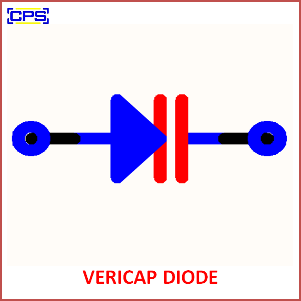A Varicap Diode, also known as a Varactor Diode, is a type of semiconductor diode whose capacitance varies with the applied reverse voltage. Unlike regular diodes, which are used for rectification, varicap diodes are designed specifically to exploit the relationship between reverse voltage and capacitance. This makes them useful in applications where the capacitance needs to be adjusted electronically, such as in tuning circuits and frequency modulation.

Key Features of a Varicap Diode:
- Voltage-Dependent Capacitance:
- The capacitance of a varicap diode decreases as the reverse bias voltage increases. This is because the width of the depletion region changes with the applied voltage, affecting the capacitance.
- No Current Flow in Normal Operation:
- Like regular diodes, varicap diodes are typically used in reverse bias, so no current flows through them during normal operation.
- Wide Capacitance Range:
- The capacitance can vary widely depending on the specific diode’s design, from a few picofarads (pF) to several hundred picofarads.
- Tuning Capability:
- Varicap diodes are commonly used to electronically tune the capacitance in circuits, providing an easy way to adjust frequency or resonant conditions.
Working Principle:
- The capacitance CCC of a varicap diode is inversely proportional to the reverse bias voltage VRV_RVR. The relationship is typically expressed as: C=C0(1+VRV0)nC = \frac{C_0}{(1 + \frac{V_R}{V_0})^n}C=(1+V0VR)nC0 Where:
- C0C_0C0 is the maximum capacitance (when no reverse voltage is applied).
- VRV_RVR is the reverse bias voltage.
- V0V_0V0 and nnn are constants that depend on the material and geometry of the diode.
As the reverse voltage increases, the depletion region widens, reducing the effective capacitance of the diode.
Applications of Varicap Diodes:
- Tuning Circuits:
- Used in radio-frequency (RF) circuits for frequency tuning, where the capacitance of the varicap diode is varied to adjust the resonant frequency of an oscillator or filter.
- Frequency Modulation (FM) Systems:
- Varicap diodes are used to modulate the frequency of a signal in FM transmitters and receivers.
- Automatic Frequency Control (AFC):
- Employed in AFC circuits, where they help maintain a stable frequency by automatically adjusting the frequency of an oscillator.
- Voltage-Controlled Oscillators (VCOs):
- A varicap diode can be used to control the frequency of oscillators in applications like phase-locked loops (PLLs) and frequency synthesis.
- TV and Radio Tuners:
- In older analog television and radio tuners, varicap diodes were used for electronically tuning to different channels.
Advantages:
- Electronic Tuning: Provides precise electronic control of capacitance, ideal for applications where manual tuning is impractical.
- Small Size: Varicap diodes are small and can be easily integrated into circuits without requiring large physical components.
- Low Power Consumption: As they operate in reverse bias, varicap diodes consume very little power.
Disadvantages:
- Limited Capacitance Range: The capacitance range may be smaller compared to other variable capacitors.
- Non-linear Behavior: The relationship between reverse bias voltage and capacitance is non-linear, which can sometimes make precise tuning challenging in certain applications.
- Temperature Sensitivity: The capacitance of varicap diodes may be affected by temperature changes, impacting performance in sensitive applications.
